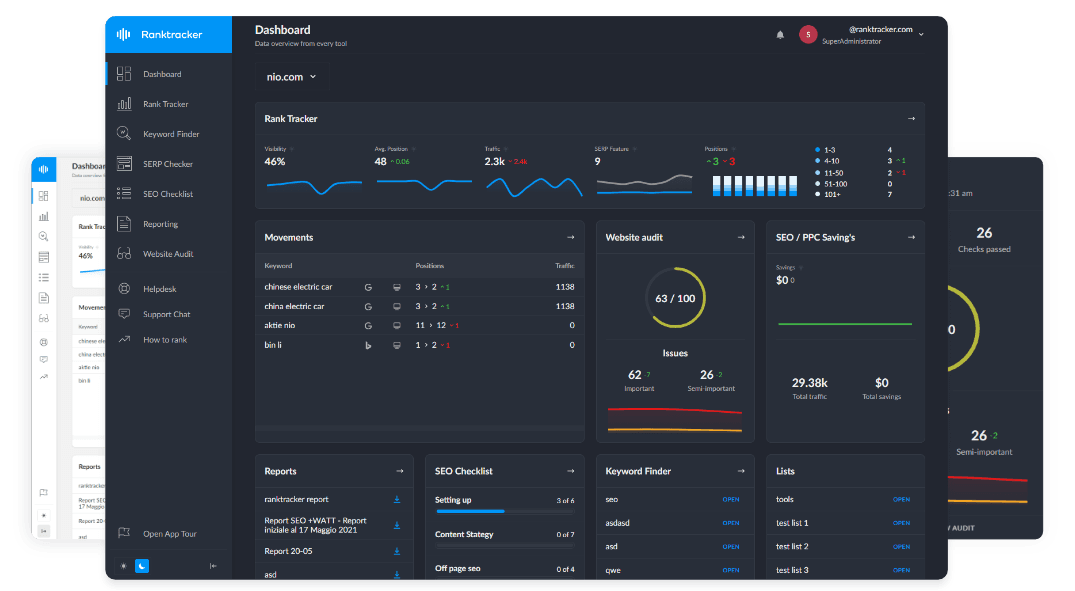Intro
On average, more than 90% of businesses use social media. Competition is cutthroat over the internet, and attention spans are short. This means that you risk losing out severely if you are not among the first options in a search engine ranking.
Strategic insights matter more than ever in 2025 as a result. To choose which SEO metrics suit your business the most, your plan must have some thought behind it! Read on to learn more about this and discover the steps to make the right choice and drive business growth.
1. Align Metrics With Your Business Goals
Every business has unique objectives and must track different metrics to reflect those goals. Here are two examples of this:
- An e-commerce company: The primary goal may be to maximize revenue from organic search traffic. The key metric to track here is organic revenue per landing page. This business can use Google Analytics to attribute sales to specific landing pages that received organic traffic.
- A local plumbing company: Local service-based businesses may be most interested in tracking how their service ranks for geo-specific queries like ‘’emergency plumber in [city]”. A suitable metric to track is local keyword rankings.
This proves that you must not chase vanity metrics that do not contribute much to real growth. To align SEO KPIs (key performance indicators) with the sales funnel, you must first define your sales funnel stages**.** Break your customer journey into three parts: awareness, consideration, and conversion. Then, map SEO metrics on each stage**.**
1.Awareness stage: The goal is to attract new visitors and build brand visibility. Here, you need to work on brand perception. Track Impressions (via Google Search Console), compare branded vs. non-branded traffic, and monitor new users from organic growth. 2.Consideration stage: Engage users and build trust. Monitor their interest levels by tracking session duration, pages per visit, scroll depth, and bounce rate. 3.Conversion stage: You need to track business outcomes now. Monitor form fills, trial sign-ups, and purchases to track goal completion.
This approach will help make your objectives concise, allowing you to choose the most suitable metrics with ease.
2. Track Core SEO Metrics

Photo courtesy of Unsplash
SEO success hinges on a technically sound foundation. Core SEO metrics comprise this foundation; they make your site accessible, fast, and indexable. Let’s see what these metrics are and how you can make the most of them.
- Crawlability and indexability: Crawlability ensures search engines can access your site, while indexability allows your page to appear in search results. Use Google Search Console to find blocked URLs, noindex tags, crawl errors, and robots.txt issues. Fixing these dead ends can help you maintain full visibility in searches.
- Mobile usability: Most people access websites using their phones. This is where mobile-first indexing comes in; your site must work flawlessly on smaller screens. Use Google Search Console’s Mobile Usability report to test responsiveness and tap target sizes. This will bring all mobile-specific errors to light for you to fix and ensure a seamless experience for mobile users.
- Technical errors: Issues like broken links, duplicate content, and incorrect canonicals weaken SEO. Use services such as Screaming Frog to identify and fix 404s, redirect loops, duplicate meta tags, and schema errors. This will help you maintain a clean technical profile and ensure smooth navigation for users.
You can also use Page Speed Insights or Google Search Console to monitor other vital scores like LCP (loading speed), FID (interactivity), and CLS (visual stability).
3. Focus on Engagement and Experience
User behaviour is central to a sound and effective SEO strategy. Google continues to rely on behavioral signals in 2025, since they demonstrate the user experience. Signals like dwell time, bounce rate, and scroll depth directly reflect how users interact with your page. Google uses these metrics to judge your content’s quality and relevance. You must focus on these key behavioral metrics to optimize your site for engagement:
- Click-through rates (CTR): A high CTR means that your titles and meta descriptions are on the right track and attracting attention.
- Bounce rate and dwell time: These essentially measure whether the users find your content engaging. If users are leaving quickly, it usually means that your content is not compelling or interesting enough. In contrast, long dwell times suggest relevance and depth.
- Scroll depth and session duration: These are connected to the dwell times, but they go further and show how far users explore your content. They highlight interest and usability.
- Heatmaps and session recordings: You can use these to monitor exactly where users click, scroll, or drop off to judge and update accordingly. Tools like Hotjar or Microsoft Clarity can reveal this information.
- Site experience factors: The factors that we discussed above (page speed, mobile design, layout clarity) also contribute to deeper engagement.
However, in 2025, you have the option of going beyond generic engagement metrics and understanding who your users are to enhance their experience. We call this identity-driven (ID) marketing. It applies to SEO in the following ways:
- Helps segment your audience and tailor content based on user intent or persona.
- Creates personalized landing pages to increase relevance and conversion.
- Acts as a bridge between SEO and CRO (conversion rate optimization) (see below), ensuring that your content is not only discoverable but also actionable.
Combining your SEO performance with ID marketing strategies can yield numerous benefits to your business. Scared to try this out? Worry not! You can partner with a Boise, ID marketing agency to create highly relevant, personalized experiences. As a result, you can boost engagement, improve behavior signals, and strengthen organic rankings.
4. Zero in On Conversion Metrics

The All-in-One Platform for Effective SEO
Behind every successful business is a strong SEO campaign. But with countless optimization tools and techniques out there to choose from, it can be hard to know where to start. Well, fear no more, cause I've got just the thing to help. Presenting the Ranktracker all-in-one platform for effective SEO
We have finally opened registration to Ranktracker absolutely free!
Create a free accountOr Sign in using your credentials
Photo courtesy of Pexels
Traffic is great, but there is no business value without conversion. Think of it this way: a customer comes into your store, looks around, then leaves without buying anything. Did you make anything out of that interaction? Probably not. SEO follows the same principle. It’s no longer just about bringing visitors. Instead, it’s about bringing the right visitors who take meaningful actions.
Conversion metrics must be clear in your SEO strategy. First, you need to define what a ‘’conversion’’ is for your business. Is it a purchase or a form submission, or is it something different, like a phone call or a newsletter signup? Once you identify this, set up goal tracking in GA4 and integrate with your preferred platform to view conversions by landing page, keyword, or traffic source. Monitoring conversion rates in isolation is not enough. You must monitor these by segment to effectively refine your SEO strategy:
- By device: Do mobile users convert at a lower rate than desktop users? If so, is it because of poor mobile usability, slow load times, form issues, or something else?
- By traffic segment: How do first-time visitors perform against repeat visitors? Assess your brand familiarity and evaluate your retargeting strategies.
- By content type: Where do your how-to guides outperform product-focused pages? Is there any content that could benefit from more or fewer CTAs? This will signal whether you need to shift your content mix.
- By geography: Are there particular regions that underperform? Review your localized messages, and don’t forget to check on region-specific UX barriers.
- By landing page: Is there a page that consistently performs better than others? Audit your top-performing pages to identify elements you could replicate elsewhere.
Use tools like GA4 or HubSpot to dig into these segmented metrics. This will allow you to conduct an in-depth assessment of your conversion rates, helping you refine your strategies accordingly.
5. Embrace Predictive and AI-Driven Metrics
As SEO tools become smarter in 2025, you must start looking ahead, not just back. Predictive analytics can do wonders here, allowing you to stay ahead of an increasingly complex and competitive business landscape. Here is what you can do with AI-driven metrics in your SEO strategy:
- Anticipate performance trends: These metrics help you forecast organic traffic using historical data and algorithm trends. As a result, you can prepare well for traffic dips and surges.
- Optimize content planning in advance: Forecasting tools let you align your calendar with expected traffic patterns. This way, you can plan ahead instead of just reacting to SEO changes.
- Spot content decay early: AI-driven metrics tell you when high-performing pages begin to slip in rankings. As a result, you can refresh your content before losing all your traffic, maintaining consistent visibility.
- Leverage seasonal demand: AI tools can detect seasonal search trends and help you publish at the right time. Your content will consequently be indexed and competitive exactly when demand spikes.
- Avoid wasted SEO spend: Predictive measures can forecast underperforming trends, helping you avoid investment in low-return strategies.
However, you must take proactive measures to reap these benefits. Align your content calendar with forecasted demand using AI-powered tools to optimize your content strategy. Refresh and republish early to preserve rankings and avoid sudden traffic drops.
Go live just before the peak of seasonal spikes in search behavior, and be sure to look for underperforming keywords or contact segments. AI has advantages, but you must stay on top of your strategy. Analyze patterns, act on insights, and continuously refine your approach to stay ahead of the competition.
Endnote
The right SEO metrics are more than complex words or figures. Instead, they are strategic insights that you must align with your business goals. Follow the points above and embrace topic-focused visibility to move beyond vanity metrics. Remember, the end goal is sustainable, data-driven growth.

